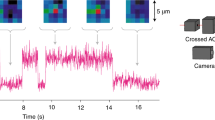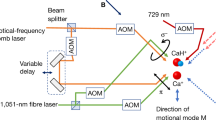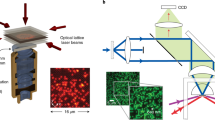Abstract
Quantum sensing and metrology use coherent superposition states of quantum systems to detect and measure physical effects of interest. Their sensitivity is typically limited by the standard quantum limit, which bounds the achievable precision in measurements involving nominally identical but uncorrelated quantum systems. Fully quantum metrology involves entanglement in an array of quantum systems, enabling uncertainty reduction below the standard quantum limit. Although ultracold atoms have been widely used for applications such as atomic clocks or gravitational sensors, molecules show higher sensitivity to many interesting phenomena, including the existence of new, symmetry-violating forces mediated by massive particles. Recent advancements in molecular cooling, trapping and control techniques have enabled the use of molecules for quantum sensing and metrology. This Review describes these advancements and explores the potential of the rich internal structure and enhanced coupling strengths of molecules to probe fundamental physics and drive progress in the field.
This is a preview of subscription content, access via your institution
Access options
Access Nature and 54 other Nature Portfolio journals
Get Nature+, our best-value online-access subscription
$29.99 / 30 days
cancel any time
Subscribe to this journal
Receive 12 print issues and online access
$209.00 per year
only $17.42 per issue
Buy this article
- Purchase on Springer Link
- Instant access to full article PDF
Prices may be subject to local taxes which are calculated during checkout




Similar content being viewed by others
References
Safronova, M. S. et al. Search for new physics with atoms and molecules. Rev. Mod. Phys. 90, 025008 (2018).
DeMille, D. Diatomic molecules, a window onto fundamental physics. Phys. Today 68, 34–40 (2015).
Hutzler, N. R. Polyatomic molecules as quantum sensors for fundamental physics. Quantum Sci. Technol. 5, 044011 (2020).
Sushkov, P. & Flarnbaum, V. Parity breaking effects in diatomic molecules. Zh. Eksp. Teor. Fiz. 75, 1208–1213 (1978).
Salumbides, E. J. et al. Bounds on fifth forces from precision measurements on molecules. Phys. Rev. D 87, 112008 (2013).
Borkowski, M. et al. Weakly bound molecules as sensors of new gravitylike forces. Sci. Rep. 9, 14807 (2019).
Hutzler, N. R., Lu, H.-I. & Doyle, J. M. The buffer gas beam: an intense, cold, and slow source for atoms and molecules. Chem. Rev. 112, 4803–4827 (2012).
Shuman, E. S., Barry, J. F. & DeMille, D. Laser cooling of a diatomic molecule. Nature 467, 820–823 (2010).
Fitch, N. J. & Tarbutt, M. R. Laser-cooled molecules. Adv. Mol. Opt. Phys. 70, 157–262 (2021).
Augenbraun, B. L. et al. Direct laser cooling of polyatomic molecules. Adv. At. Mol. Opt. Phys. 72, 89–182 (2023).
Bohn, J. L., Rey, A. M. & Ye, J. Cold molecules: progress in quantum engineering of chemistry and quantum matter. Science 357, 1002–1010 (2017).
De Marco, L. et al. A degenerate Fermi gas of polar molecules. Science 363, 853–856 (2019).
Schindewolf, A. et al. Evaporation of microwave-shielded polar molecules to quantum degeneracy. Nature 607, 677–681 (2022).
Bigagli, N. et al. Observation of Bose–Einstein condensation of dipolar molecules. Preprint at https://arxiv.org/abs/2302.10161 (2023).
Langen, T., Valtolina, G., Wang, D. & Ye, J. Quantum state manipulation and cooling of ultracold molecules. Nat. Phys. https://doi.org/10.1038/s41567-024-02423-1 (2024).
Dine, M. & Kusenko, A. Origin of the matter–antimatter asymmetry. Rev. Mod. Phys. 76, 1–30 (2003).
Baron, J. et al. Order of magnitude smaller limit on the electric dipole moment of the electron. Science 343, 269–272 (2014).
Andreev, V. et al. Improved limit on the electric dipole moment of the electron. Nature 562, 355–360 (2018).
Roussy, T. S. et al. An improved bound on the electron’s electric dipole moment. Science 381, 46–50 (2023).
Ema, Y., Gao, T. & Pospelov, M. Standard model prediction for paramagnetic electric dipole moments. Phys. Rev. Lett. 129, 231801 (2022).
Fleig, T. & Nayak, M. K. Electron electric dipole moment and hyperfine interaction constants for ThO. J. Mol. Spectrosc. 300, 16–21 (2014).
Skripnikov, L. V. Combined 4-component and relativistic pseudopotential study of ThO for the electron electric dipole moment search. J. Chem. Phys. 145, 214301 (2016).
Hudson, J. J. et al. Improved measurement of the shape of the electron. Nature 473, 493–496 (2011).
Brown, J. M. & Carrington, A. Rotational Spectroscopy of Diatomic Molecules (Cambridge Univ. Press, 2003); https://doi.org/10.1017/CBO9780511814808
DeMille, D. et al. Search for the electric dipole moment of the electron using metastable PbO. AIP Conf. Proc. 596, 72–83 (2001).
Wu, X. et al. Electrostatic focusing of cold and heavy molecules for the ACME electron EDM search. New J. Phys. 24, 073043 (2022).
Ang, D. G. et al. Measurement of the H 3Δ1 radiative lifetime in ThO. Phys. Rev. A 106, 022808 (2022).
Cho, D., Sangster, K. & Hinds, E. A. Search for time-reversal-symmetry violation in thallium fluoride using a jet source. Phys. Rev. A 44, 2783–2799 (1991).
Alarcon, R. et al. Electric dipole moments and the search for new physics. Preprint at https://arxiv.org/abs/2203.08103 (2022).
Arrowsmith-Kron, G. et al. Opportunities for fundamental physics research with radioactive molecules. Rep. Prog. Phys. https://doi.org/10.1088/1361-6633/ad1e39 (2023).
O Grasdijk, O. et al. CeNTREX: a new search for time-reversal symmetry violation in the 205Tl nucleus. Quantum Sci. Technol. 6, 044007 (2021).
Auerbach, N., Flambaum, V. V. & Spevak, V. Collective T- and P-odd electromagnetic moments in nuclei with octupole deformations. Phys. Rev. Lett. 76, 4316–4319 (1996).
Flambaum, V. Spin hedgehog and collective magnetic quadrupole moments induced by parity and time invariance violating interaction. Phys. Lett. B 320, 211–215 (1994).
Flambaum, V., DeMille, D. & Kozlov, M. Time-reversal symmetry violation in molecules induced by nuclear magnetic quadrupole moments. Phys. Rev. Lett. 113, 103003 (2014).
DeMille, D., Cahn, S. B., Murphree, D., Rahmlow, D. A. & Kozlov, M. G. Using molecules to measure nuclear spin-dependent parity violation. Phys. Rev. Lett. 100, 023003 (2008).
Altuntaş, E., Ammon, J., Cahn, S. B. & DeMille, D. Demonstration of a sensitive method to measure nuclear-spin-dependent parity violation. Phys. Rev. Lett. 120, 142501 (2018).
Norrgard, E. B. et al. Nuclear-spin dependent parity violation in optically trapped polyatomic molecules. Commun. Phys. 2, 77 (2019).
Karthein, J. et al. Electroweak nuclear properties from single molecular ions in a Penning trap. Preprint at https://arxiv.org/abs/2310.11192 (2023).
Bothwell, T. et al. Resolving the gravitational redshift across a millimetre-scale atomic sample. Nature 602, 420–424 (2022).
Leung, K. H. et al. Terahertz vibrational molecular clock with systematic uncertainty at the 10−14 level. Phys. Rev. X 13, 011047 (2023).
Barontini, G. et al. Measuring the stability of fundamental constants with a network of clocks. EPJ Quantum Technol. 9, 12 (2022).
Hanneke, D., Kuzhan, B. & Lunstad, A. Optical clocks based on molecular vibrations as probes of variation of the proton-to-electron mass ratio. Quantum Sci. Technol. 6, 014005 (2021).
Riehle, F., Gill, P., Arias, F. & Robertsson, L. The CIPM list of recommended frequency standard values: guidelines and procedures. Metrologia 55, 188 (2018).
Bertone, G. & Hooper, D. History of dark matter. Rev. Mod. Phys. 90, 045002 (2018).
Uzan, J.-P. Varying constants, gravitation and cosmology. Living Rev. Relativ. 14, 2 (2011).
Lange, R. et al. Improved limits for violations of local position invariance from atomic clock comparisons. Phys. Rev. Lett. 126, 011102 (2021).
Kobayashi, J., Ogino, A. & Inouye, S. Measurement of the variation of electron-to-proton mass ratio using ultracold molecules produced from laser-cooled atoms. Nat. Commun. 10, 3771 (2019).
Patra, S. et al. Proton-electron mass ratio from laser spectroscopy of HD+ at the part-per-trillion level. Science 369, 1238–1241 (2020).
Alighanbari, S., Giri, G. S., Constantin, F. L., Korobov, V. I. & Schiller, S. Precise test of quantum electrodynamics and determination of fundamental constants with HD+ ions. Nature 581, 152–158 (2020).
Germann, M. et al. Three-body QED test and fifth-force constraint from vibrations and rotations of HD+. Phys. Rev. Res. 3, 022028 (2021).
Heacock, B. et al. Pendellösung interferometry probes the neutron charge radius, lattice dynamics, and fifth forces. Science 373, 1239–1243 (2021).
Tiberi, E., Borkowski, M., Iritani, B. Moszynski, R. & Zelevinsky, T. Searching for New Fundamental Interactions via Isotopic Shifts in Molecular Lattice Clocks. Preprint at https://arxiv.org/abs/2403.07097 (2024).
Wineland, D. J., Bollinger, J. J., Itano, W. M., Moore, F. L. & Heinzen, D. J. Spin squeezing and reduced quantum noise in spectroscopy. Phys. Rev. A 46, 6797–6800 (1992).
Wineland, D. J., Bollinger, J. J., Itano, W. M. & Heinzen, D. J. Squeezed atomic states and projection noise in spectroscopy. Phys. Rev. A 50, 67–88 (1994).
Ma, J., Wang, X., Sun, C. P. & Nori, F. Quantum spin squeezing. Phys. Rep. 509, 89–165 (2011).
Kitagawa, M. & Ueda, M. Squeezed spin states. Phys. Rev. A 47, 5138–5143 (1993).
Ritsch, H., Domokos, P., Brennecke, F. & Esslinger, T. Cold atoms in cavity-generated dynamical optical potentials. Rev. Mod. Phys. 85, 553–601 (2013).
Hosten, O., Engelsen, N. J., Krishnakumar, R. & Kasevich, M. A. Measurement noise 100 times lower than the quantum-projection limit using entangled atoms. Nature 529, 505–508 (2016).
Cox, K. C., Greve, G. P., Weiner, J. M. & Thompson, J. K. Deterministic squeezed states with collective measurements and feedback. Phys. Rev. Lett. 116, 093602 (2016).
Pedrozo-Peñafiel, E. et al. Entanglement on an optical atomic-clock transition. Nature 588, 414–418 (2020).
Pezzè, L., Smerzi, A., Oberthaler, M. K., Schmied, R. & Treutlein, P. Quantum metrology with nonclassical states of atomic ensembles. Rev. Mod. Phys. 90, 035005 (2018).
Perlin, M. A., Qu, C. & Rey, A. M. Spin squeezing with short-range spin-exchange interactions. Phys. Rev. Lett. 125, 223401 (2020).
Bilitewski, T. et al. Dynamical generation of spin squeezing in ultracold dipolar molecules. Phys. Rev. Lett. 126, 113401 (2021).
Yan, B. et al. Observation of dipolar spin-exchange interactions with lattice-confined polar molecules. Nature 501, 521–525 (2013).
Hazzard, K. R. A. et al. Many-body dynamics of dipolar molecules in an optical lattice. Phys. Rev. Lett. 113, 195302 (2014).
Christakis, L. et al. Probing site-resolved correlations in a spin system of ultracold molecules. Nature 614, 64–69 (2023).
Holland, C. M., Lu, Y. & Cheuk, L. W. On-demand entanglement of molecules in a reconfigurable optical tweezer array. Science 382, 1143–1147 (2023).
Bao, Y. et al. Dipolar spin-exchange and entanglement between molecules in an optical tweezer array. Science 382, 1138–1143 (2023).
Bornet, G. et al. Scalable spin squeezing in a dipolar Rydberg atom array. Nature 621, 728–733 (2023).
Eckner, W. J. et al. Realizing spin squeezing with Rydberg interactions in a programmable optical clock. Nature 621, 734–739 (2023).
Franke, J. et al. Quantum-enhanced sensing on optical transitions through finite-range interactions. Nature 621, 740–745 (2023).
Hines, J. A. et al. Spin squeezing by Rydberg dressing in an array of atomic ensembles. Phys. Rev. Lett. 131, 063401 (2023).
Gorshkov, A. V. et al. Tunable superfluidity and quantum magnetism with ultracold polar molecules. Phys. Rev. Lett. 107, 115301 (2011).
Hazzard, K. R. A., Manmana, S. R., Foss-Feig, M. & Rey, A. M. Far-from-equilibrium quantum magnetism with ultracold polar molecules. Phys. Rev. Lett. 110, 075301 (2013).
Wellnitz, D., Mamaev, M., Bilitewski, T. & Rey, A. M. Spin squeezing with itinerant dipoles: a case for shallow lattices. Phys. Rev. Res. 6, 012025 (2024).
Gorshkov, A. V. et al. Quantum magnetism with polar alkali-metal dimers. Phys. Rev. A 84, 033619 (2011).
Tscherbul, T. V., Ye, J. & Rey, A. M. Robust nuclear spin entanglement via dipolar interactions in polar molecules. Phys. Rev. Lett. 130, 143002 (2023).
Hermsmeier, R., Rey, A. M. & Tscherbul, T. V. Magnetically tunable electric dipolar interactions of ultracold polar molecules in the quantum ergodic regime. Preprint at https://arxiv.org/abs/2401.04902 (2024).
Zhang, C., Yu, P., Jadbabaie, A. & Hutzler, N. R. Quantum-enhanced metrology for molecular symmetry violation using decoherence-free subspaces. Phys. Rev. Lett. 131, 193602 (2023).
Garcia Ruiz, R. F. et al. Spectroscopy of short-lived radioactive molecules. Nature 581, 396–400 (2020).
Piskorski, J., Patterson, D., Eibenberger, S. & Doyle, J. M. Cooling, spectroscopy and non-sticking of trans-stilbene and Nile Red. ChemPhysChem 15, 3800–3804 (2014).
Patterson, D. & Doyle, J. M. Sensitive chiral analysis via microwave three-wave mixing. Phys. Rev. Lett. 111, 023008 (2013).
Norrgard, E. B., Eckel, S. P., Holloway, C. L. & Shirley, E. L. Quantum blackbody thermometry. New J. Phys. 23, 033037 (2021).
Arvanitaki, A., Dimopoulos, S. & Van Tilburg, K. Resonant absorption of bosonic dark matter in molecules. Phys. Rev. X 8, 041001 (2018).
Eibenberger, S., Doyle, J. & Patterson, D. Enantiomer-specific state transfer of chiral molecules. Phys. Rev. Lett. 118, 123002 (2017).
Doyle, J. M., Lasner, Z. D. & Augenbraun, B. L. High sensitivity chiral detection in the gas phase via microwave spectroscopy and the possible frontier of ultracold chiral molecules. Chiral Matter 167, 195–207 (2023).
Quack, M., Stohner, J. & Willeke, M. High-resolution spectroscopic studies and theory of parity violation in chiral molecules. Annu. Rev. Phys. Chem. 59, 741–769 (2008).
Cornish, S. L., Tarbutt, M. R. & Hazzard, K. R. A. Quantum computation and quantum simulation with ultracold molecules. Nat. Phys. https://doi.org/10.1038/s41567-024-02453-9 (2024).
Baron, J. et al. Methods, analysis, and the treatment of systematic errors for the electron electric dipole moment search in thorium monoxide. New J. Phys. 19, 073029 (2017).
Fitch, N. J., Lim, J., Hinds, E. A., Sauer, B. E. & Tarbutt, M. R. Methods for measuring the electron’s electric dipole moment using ultracold YbF molecules. Quantum Sci. Technol. 6, 014006 (2021).
Kozyryev, I. & Hutzler, N. R. Precision measurement of time-reversal symmetry violation with laser-cooled polyatomic molecules. Phys. Rev. Lett. 119, 133002 (2017).
Takahashi, Y., Zhang, C., Jadbabaie, A. & Hutzler, N. R. Engineering field-insensitive molecular clock transitions for symmetry violation searches. Phys. Rev. Lett. 131, 183003 (2023).
Anderegg, L. et al. Quantum control of trapped polyatomic molecules for eEDM searches. Science 382, 665–668 (2023).
Fleig, T. & DeMille, D. Theoretical aspects of radium-containing molecules amenable to assembly from laser-cooled atoms for new physics searches. New J. Phys. 23, 113039 (2021).
Kłos, J., Li, H., Tiesinga, E. & Kotochigova, S. Prospects for assembling ultracold radioactive molecules from laser-cooled atoms. New J. Phys. 24, 025005 (2022).
Singh, J. T. A new concept for searching for time-reversal symmetry violation using Pa-229 ions trapped in optical crystals. Hyperfine Interact. 240, 29 (2019).
Flambaum, V. V. & Dzuba, V. A. Electric dipole moments of atoms and molecules produced by enhanced nuclear Schiff moments. Phys. Rev. A 101, 042504 (2020).
Ramachandran, H. D. & Vutha, A. C. Nuclear T-violation search using octopole-deformed nuclei in a crystal. Phys. Rev. A 108, 012819 (2023).
Kozlov, M. G. & Derevianko, A. Proposal for a sensitive search for the electric dipole moment of the electron with matrix-isolated radicals. Phys. Rev. Lett. 97, 063001 (2006).
Li, S. J., Ramachandran, H. D., Anderson, R. & Vutha, A. C. Optical control of BaF molecules trapped in neon ice. New J. Phys. 25, 082001 (2023).
Acknowledgements
We acknowledge funding support from AFOSR MURI Grant FA9550-21-1-0069 (DD, AMR, and TZ), the Gordon and Betty Moore Foundation Grant 12330 (DD), and the Brown Foundation Grant CU22-1584 (TZ) We thank S. Park and C. Miller for careful reading of the manuscript.
Author information
Authors and Affiliations
Corresponding author
Ethics declarations
Competing interests
The authors declare no competing interests.
Additional information
Publisher’s note Springer Nature remains neutral with regard to jurisdictional claims in published maps and institutional affiliations.
Rights and permissions
Springer Nature or its licensor (e.g. a society or other partner) holds exclusive rights to this article under a publishing agreement with the author(s) or other rightsholder(s); author self-archiving of the accepted manuscript version of this article is solely governed by the terms of such publishing agreement and applicable law.
About this article
Cite this article
DeMille, D., Hutzler, N.R., Rey, A.M. et al. Quantum sensing and metrology for fundamental physics with molecules. Nat. Phys. 20, 741–749 (2024). https://doi.org/10.1038/s41567-024-02499-9
Received:
Accepted:
Published:
Issue Date:
DOI: https://doi.org/10.1038/s41567-024-02499-9
This article is cited by
-
Ultracold chemistry as a testbed for few-body physics
Nature Physics (2024)



